Modified Broadband Ruthroff-Type Transmission Line Transformer Balun for Isolation-Enhanced Passive Mixer Design
Abstract
1. Introduction
2. The Adopted GaAs Technology
3. Analysis of and Improvement in TLT Balun
3.1. Concept and Challenges of Conventional Ruthroff-Type TLT Balun
3.2. Modified LO Ruthroff Balun with Shunt Capacitances and U Section
3.3. Modified RF Balun with Parallel Compensation Networks
4. Isolation-Enhanced DBM Design
- (1)
- When operating at higher frequencies, there is not enough power available to drive the LO port, resulting in a deterioration of the performance.
- (2)
- The impedance of the diode model in the PDK supplied by the foundry deviates from the actual situation, resulting in frequency offset (usually shifted toward the high-frequency band).
5. Conclusions
Author Contributions
Funding
Data Availability Statement
Conflicts of Interest
References
- Ma, T.; Hu, F. A Wideband Flat Gain Low Noise Amplifier Using Active Inductor for Input Matching. IEEE Trans. Circuits Syst. II Express Briefs 2019, 66, 904–908. [Google Scholar] [CrossRef]
- He, D.; Cui, N.; Fan, J.; Yu, Z. Design of Multiple Feedback-Based Low-Noise Amplifier with Improved Broadband Simultaneous Noise and Impedance Matching Technique. IEEE Trans. Circuits Syst. II Express Briefs 2024, 71, 582–586. [Google Scholar] [CrossRef]
- Wu, Y.-C.; Chiong, C.-C.; Tsai, J.-H.; Wang, H. A novel 30–90-GHz singly balanced mixer with broadband LO/IF. IEEE Trans. Microw. Theory Tech. 2016, 64, 4611–4623. [Google Scholar] [CrossRef]
- Jain, V.; Tzeng, F.; Zhou, L.; Heydari, P. A single-chip dualband 22–29-GHz/77–81-GHz BiCMOS transceiver for automotive radars. IEEE J. Solid-State Circuits 2009, 44, 3469–3485. [Google Scholar] [CrossRef]
- Zhu, F.; Wang, K.; Wu, K. A reconfigurable low-voltage and lowpower millimeter-wave dual-band mixer in 65-nm CMOS. IEEE Access 2019, 7, 33359–33368. [Google Scholar] [CrossRef]
- Nguyen, T.T.; Fujii, K.; Pham, A.-V. Highly Linear Distributed Mixer in 0.25-μm Enhancement-Mode GaAs pHEMT Technology. IEEE Microw. Wirel. Compon. Lett. 2017, 27, 1116–1118. [Google Scholar] [CrossRef]
- Lin, Y.-S.; Lu, C.-L.; Wang, Y.-H. A 5 to 45 GHz distributed mixer with cascoded complementary switching pairs. IEEE Microw. Wirel. Compon. Lett. 2013, 23, 495–497. [Google Scholar] [CrossRef]
- De Padova, A.; Longhi, P.E.; Colangeli, S.; Ciccognani, W.; Limiti, E. Design of a GaN-on-Si Single-Balanced Resistive Mixer for Ka-band Satcom. IEEE Microw. Wirel. Compon. Lett. 2019, 29, 56–58. [Google Scholar] [CrossRef]
- Su, C.-C.; Liu, C.-H.; Lin, C.-M.; Tsai, Y.-L.; Wang, Y.-H. A 24–44 GHz Broadband Subharmonic Mixer With Novel Isolation-Enhanced Circuit. IEEE Microw. Wirel. Compon. Lett. 2015, 25, 124–126. [Google Scholar] [CrossRef]
- Wang, C.; Hou, D.; Chen, J.; Hong, W. A Dual-Band Switchable MMIC Star Mixer. IEEE Microw. Wirel. Compon. Lett. 2019, 29, 737–740. [Google Scholar] [CrossRef]
- Yang, T.Y.; Lien, W.R.; Yang, C.C.; Chiou, H.K. A compact V-band star mixer using compensated overlay capacitors in dual baluns. IEEE Microw. Wirel. Compon. Lett. 2007, 17, 537–539. [Google Scholar] [CrossRef]
- Hu, J.; Ma, K. Analysis and Design of a Broadband Receiver Front End for 0.1-to-40-GHz Application. IEEE Trans. Circuits Syst. I Regul. Pap. 2021, 68, 2393–2403. [Google Scholar] [CrossRef]
- Lin, C.S.; Wu, P.S.; Yeh, M.C.; Fu, J.S.; Chang, H.Y.; Lin, K.Y.; Wang, H. Analysis of multiconductor coupled-line marchand baluns for miniature MMIC design. IEEE Trans. Microw. Theory Tech. 2007, 55, 1190–1198. [Google Scholar] [CrossRef]
- Lin, C.M.; Lin, H.K.; Lai, Y.A.; Chang, C.P.; Wang, Y.H. A 10–40 GHz broadband subharmonic monolithic mixer in 0.18 m CMOS technology. IEEE Microw. Wirel. Compon. Lett. 2009, 19, 95–97. [Google Scholar]
- Lin, C.H.; Lai, Y.A.; Chiu, J.C.; Wang, Y.H. A 23–37 GHz miniature MMIC subharmonic mixer. IEEE Microw. Wirel. Components Lett. 2007, 17, 679–681. [Google Scholar] [CrossRef]
- He, D.; Yu, M.; Li, J.; Yu, Z. An 18–50-GHz Double-Balanced GaAs Mixer Using Novel Ultrawideband Balun. IEEE Microw. Wirel. Technol. Lett. 2023, 33, 723–726. [Google Scholar] [CrossRef]
- Kuo, C.L.; Kuo, C.C.; Lien, C.H.; Tsai, J.H.; Wang, H. A novel reduced-size rat-race broadside coupler and its application for CMOS distributed sub-harmonic mixer. IEEE Microw. Wirel. Compon. Lett. 2008, 18, 194–196. [Google Scholar]
- Chiou, H.K.; Lin, J.Y. Symmetric offset stack balun in standard 0.13-μm CMOS technology for three broadband and low-loss balanced passive mixer designs. IEEE Trans. Microw. Theory Tech. 2011, 59, 1529–1538. [Google Scholar] [CrossRef]
- Wang, C.; Li, W.; Chen, F.; Pu, Y.; Zuo, W.; Xu, H. A 0.3–4.2-GHz Frequency-Agile Phase Shifter Based on N-Path Passive Mixers Achieving Low Rms Phase/Amplitude Error. IEEE Microw. Wirel. Technol. Lett. 2022, 32, 575–578. [Google Scholar] [CrossRef]
- Han, G.; Kinget, P.R. Double-Conversion, Noise-Cancelling Receivers Using Modulated LNTAs and Double-Layer Passive Mixers for Concurrent Signal Reception with Tuned RF Interface. IEEE Trans. Circuits Syst. I Regul. Pap. 2021, 68, 3913–3926. [Google Scholar] [CrossRef]
- Han, J.; Kwon, K. RF Receiver Front-End Employing IIP2-Enhanced 25% Duty-Cycle Quadrature Passive Mixer for Advanced Cellular Applications. IEEE Access 2020, 8, 8166–8177. [Google Scholar] [CrossRef]
- Lee, H.; Jeon, S. A GaAs p-HEMT Distributed Drain Mixer with Low LO Drive Power, High Isolation, and Zero Power Consumption. IEEE Access 2021, 9, 158420–158425. [Google Scholar] [CrossRef]
- Chen, J.-H.; Kuo, C.-C.; Hsin, Y.-M.; Wang, H. A 15–50 GHz broadband resistive FET ring mixer using 0.18-μm CMOS technology. In Proceedings of the 2010 IEEE MTT-S International Microwave Symposium, Anaheim, CA, USA, 23–28 May 2010; pp. 784–787. [Google Scholar]
- Kuo, C.-C.; Kuo, C.-L.; Kuo, C.-J.; Maas, S.A.; Wang, H. Novel miniature and broadband millimeter-wave monolithic star mixers. IEEE Trans. Microw. Theory Tech. 2008, 56, 793–802. [Google Scholar]
- Chiou, H.-K.; Chou, H.-T.; Liang, C.-J. A 35-to-83 GHz Multiconductor-Lines Signal Combiner for High Linear and Wideband Mixer. IEEE Microw. Wirel. Compon. Lett. 2013, 23, 548–550. [Google Scholar] [CrossRef]
- Grebennikov, A. Power combiners, impedance transformers and directional couplers. High Freq. Electron. 2007, 6, 20–38. [Google Scholar]
- Ruthroff, C.L. Some broadband transformers. Proc. IRE 1959, 47, 1337–1342. [Google Scholar] [CrossRef]
- Chung, H.-Y.; Chiou, H.-K.; Hsu, Y.-C.; Yang, T.-Y.; Chang, C.-L. Design of Step-Down Broadband and Low-Loss Ruthroff-Type Baluns Using IPD Technology. IEEE Trans. Compon. Packag. Manuf. Technol. 2014, 4, 967–974. [Google Scholar] [CrossRef]
- Sun, Q.; Yuan, J.; Vo, V.T.; Rezazadeh, A.A. Design and realization of spiral marchand balun using CPW multilayer GaAs technology. In Proceedings of the 2006 European Microwave Conference, Manchester, UK, 10–15 September 2006; pp. 68–71. [Google Scholar]
- Wu, P.-S.; Wang, C.-H.; Huang, T.-W.; Wang, H. Compact and broad-band millimeter-wave monolithic transformer balanced mixers. IEEE Trans. Microw. Theory Tech. 2005, 53, 3106–3114. [Google Scholar]
- Ju, I.; Cheon, C.D.; Cressler, J.D. A compact highly efficient high-power Ka-band SiGe HBT cascode frequency doubler with four-way input transformer balun. IEEE Trans. Microw. Theory Tech. 2018, 66, 2879–2887. [Google Scholar] [CrossRef]
- Hsiao, Y.-C.; Meng, C.; Peng, Y.-H. Broadband CMOS Schottky diode star mixer using coupled-CPW Marchand dual-baluns. IEEE Microw. Wirel. Compon. Lett. 2017, 27, 500–502. [Google Scholar] [CrossRef]
- Xie, H.; Fan, Y. A wideband GaAs double-balanced mixer and driver amplifier MMIC. In Proceedings of the 2018 Cross Strait Quad-Regional Radio Science and Wireless Technology Conference (CSQRWC), Xuzhou, China, 21–24 July 2018; pp. 1–3. [Google Scholar]
- Zhang, H.; Yang, L.; Jing, S.S.; Guo, Y.; Gao, H.; Zhang, Y. A 14–22 GHz Monolithic Double-Balanced Passive Mixer. In Proceedings of the 2022 International Conference on Microwave and Millimeter Wave Technology (ICMMT), Harbin, China, 12–15 August 2022; pp. 1–3. [Google Scholar]



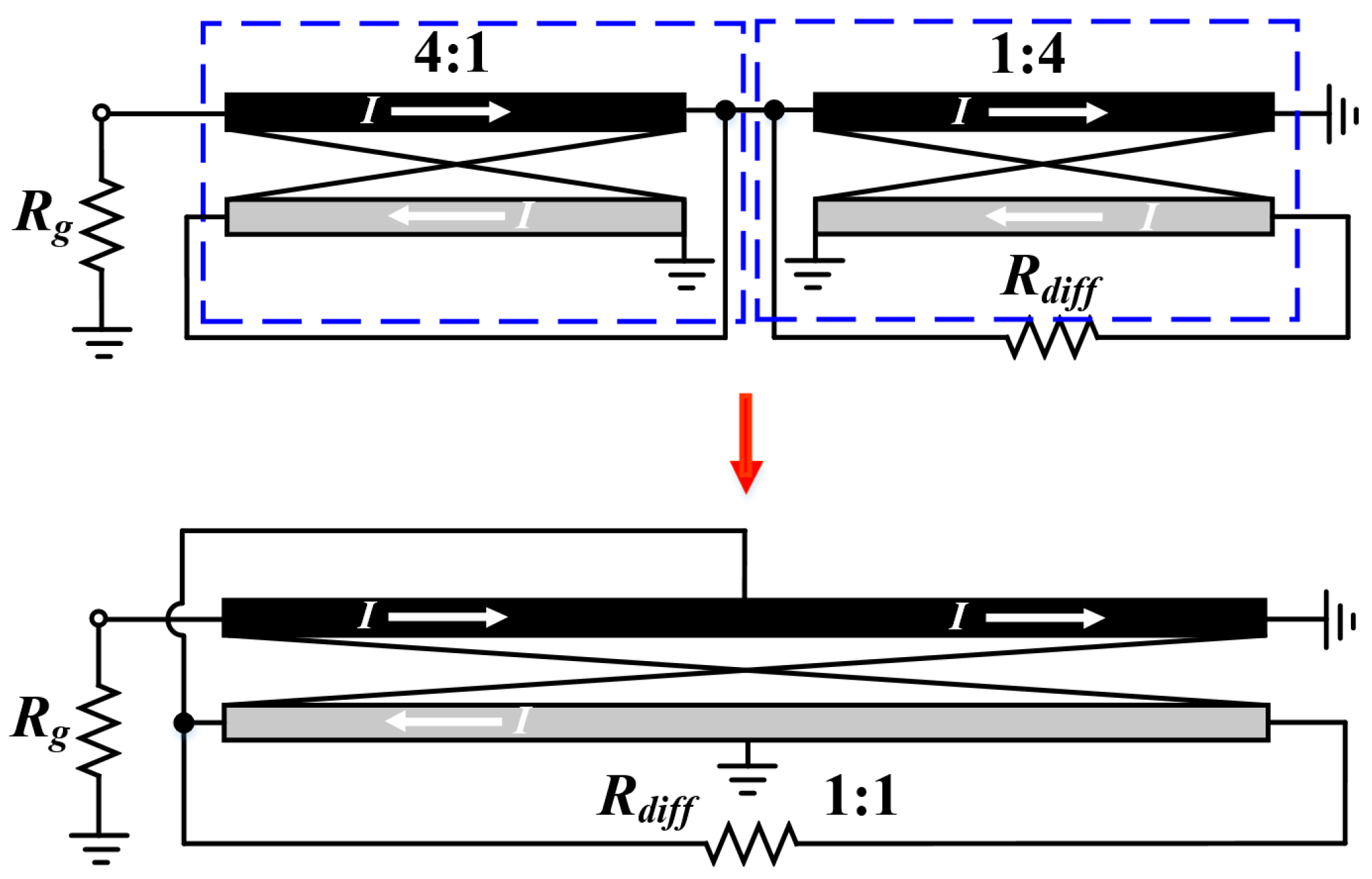

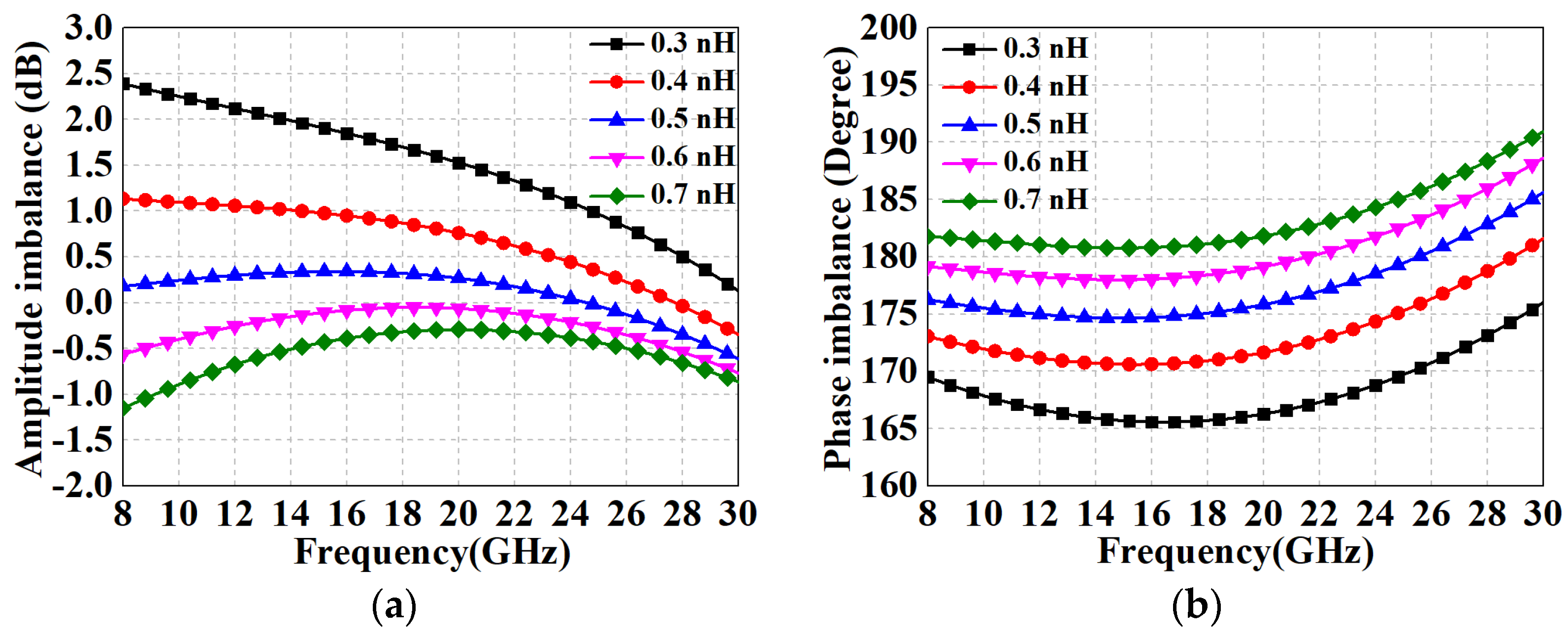


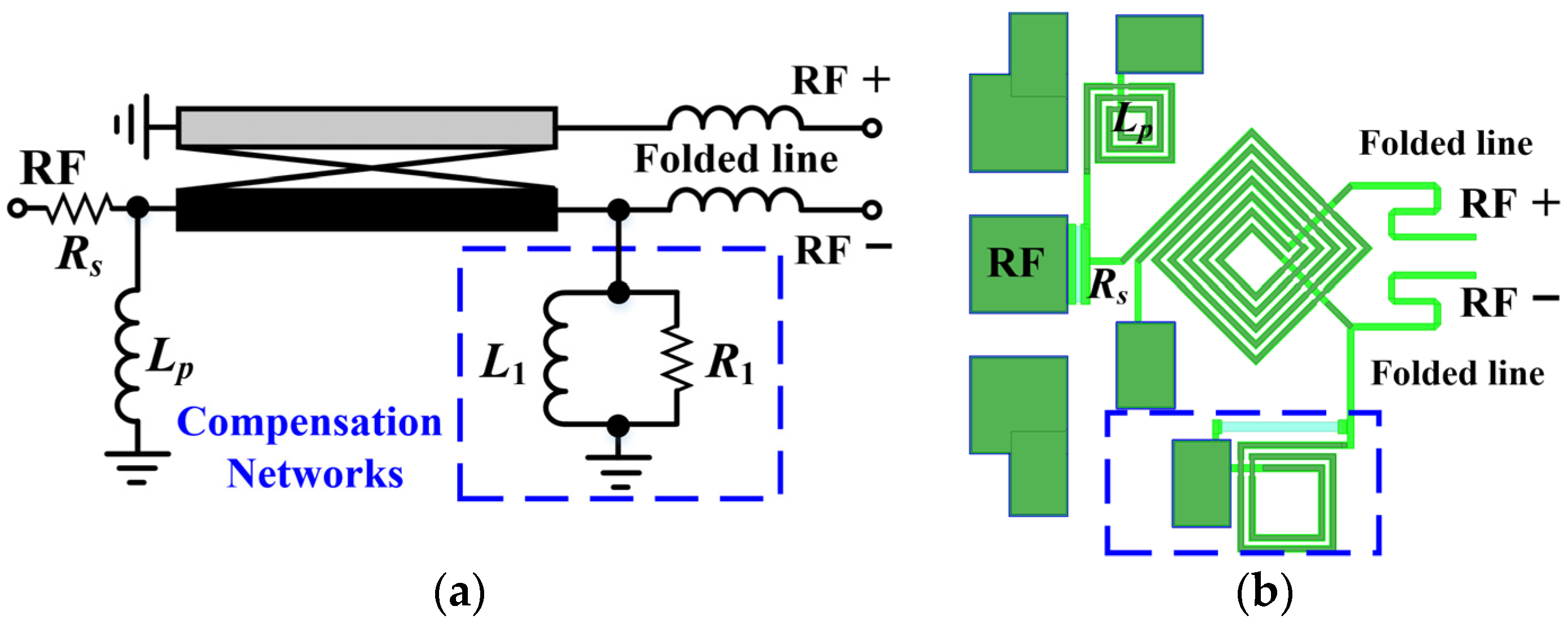



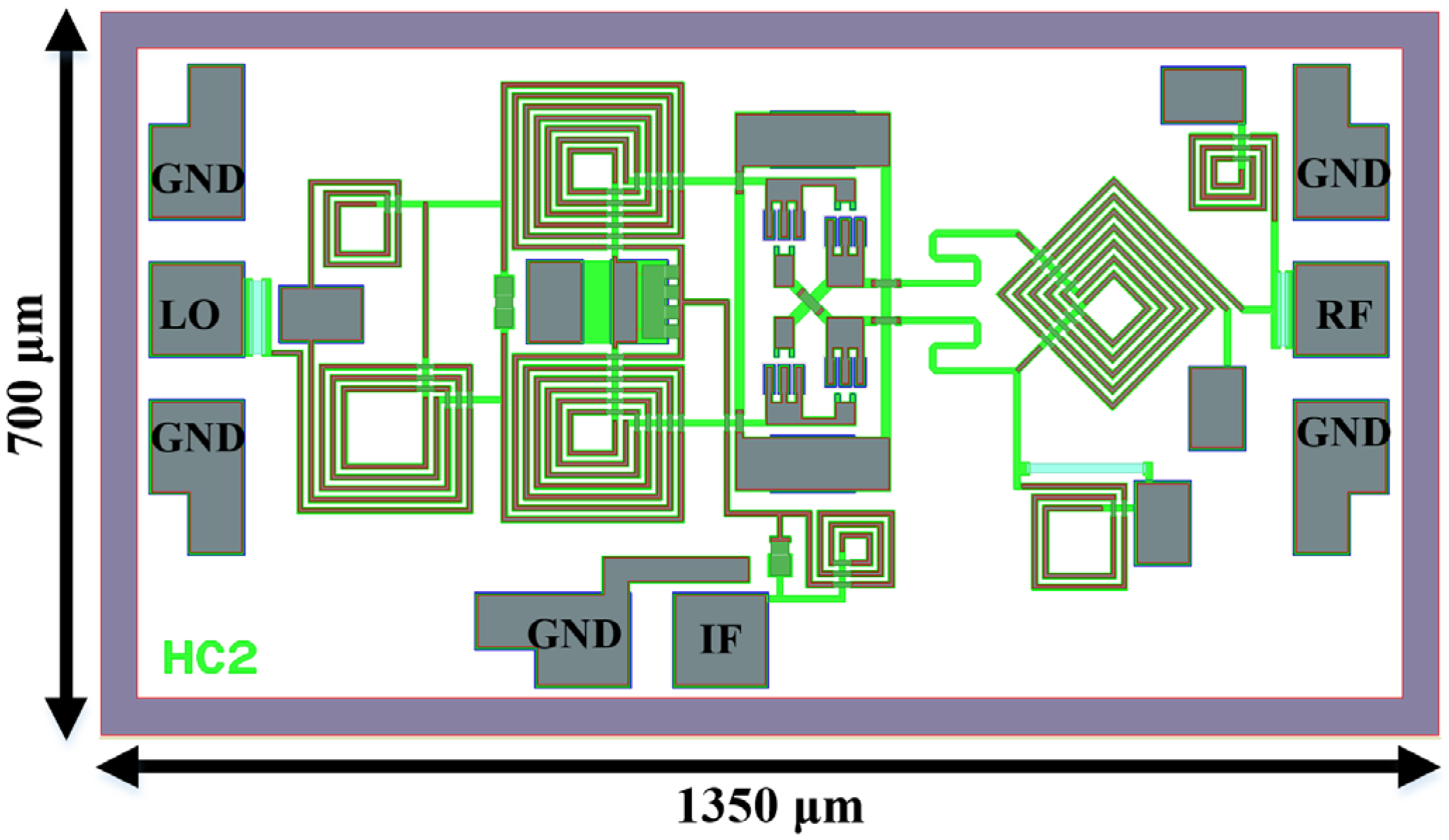
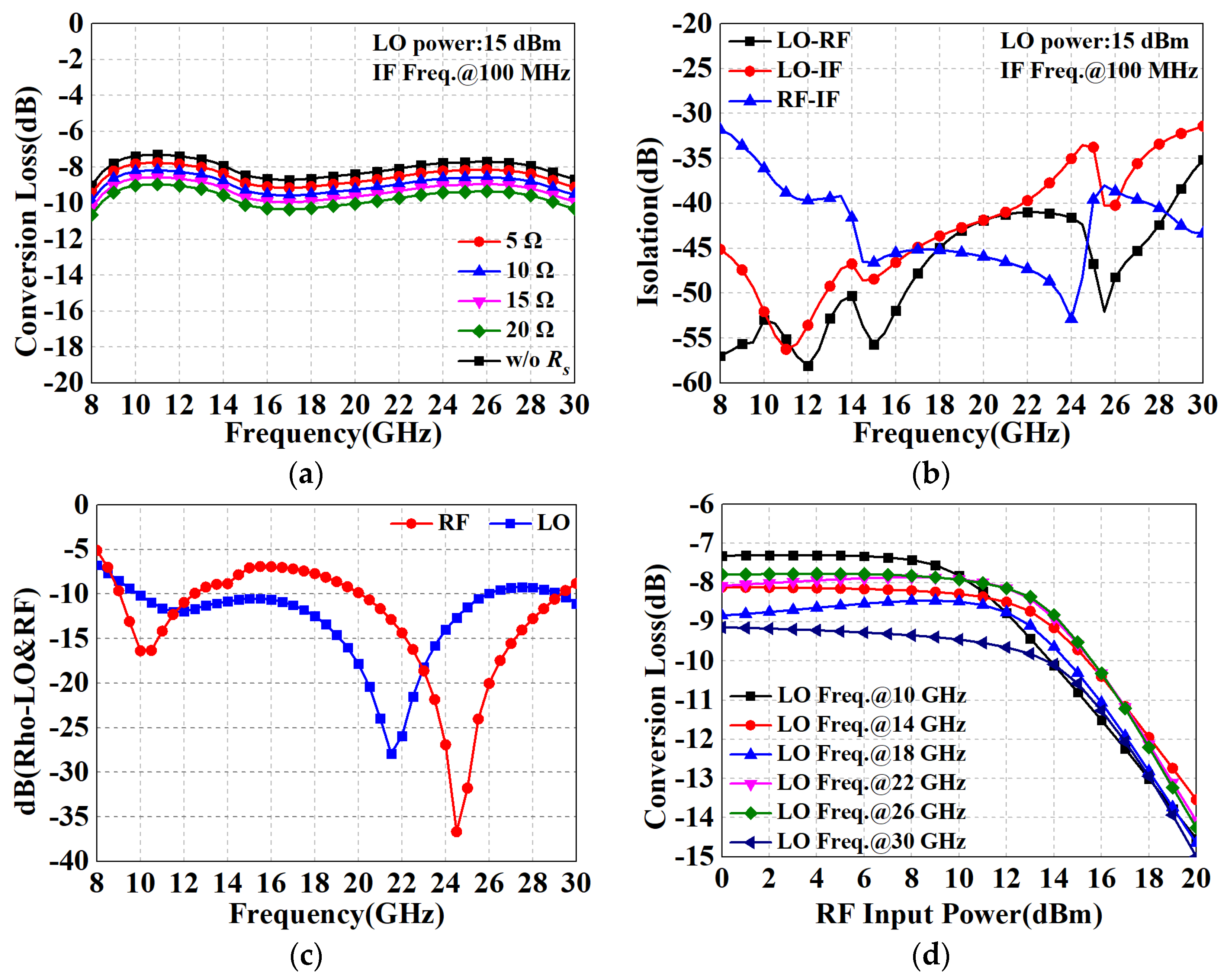
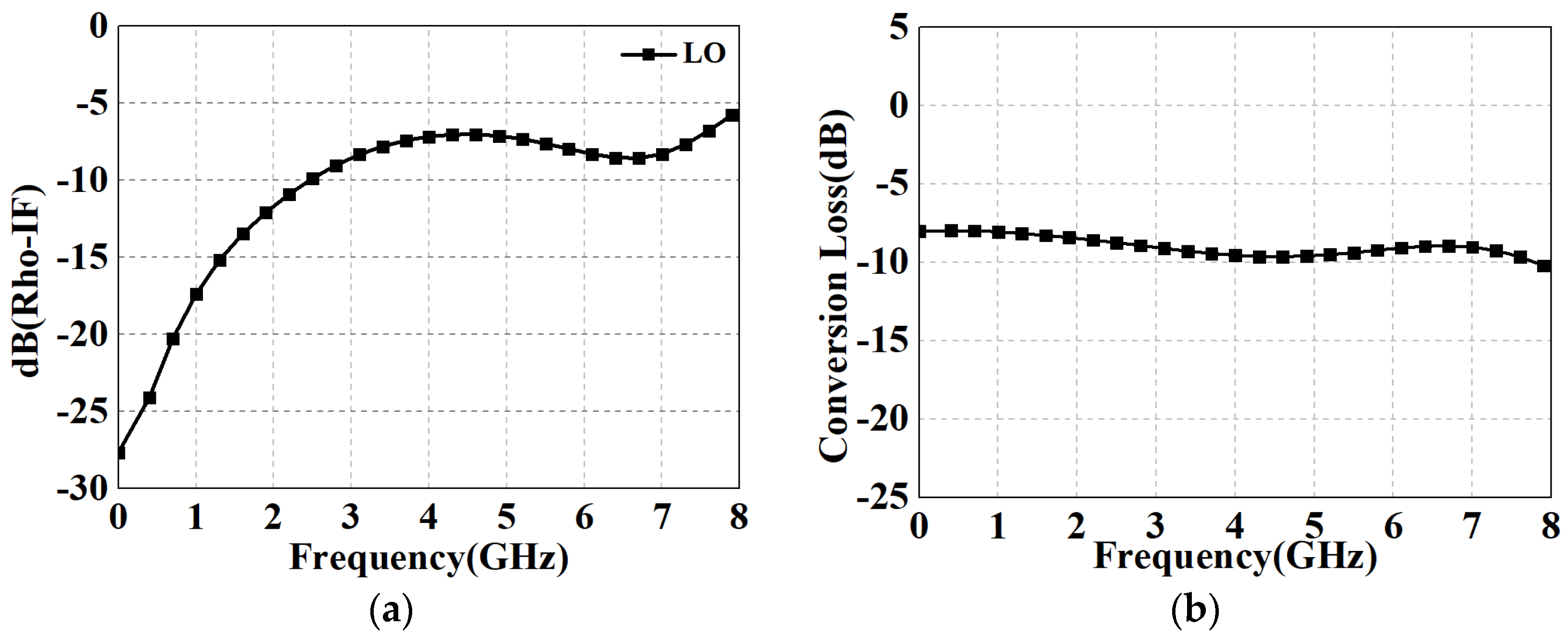
| Ref. | [29] | [30] | [31] $ | [16] $ | [32] $ | This Work $ |
| RF Freq. (GHz) | 14–28 (66.7%) | 7.5–30 (120%) | 13–20 (42.4%) | 15–60 (120%) | 15–65 (125%) | 8–30 (116%) |
| Technology | 0.15 µm GaAs | 0.15 µm GaAs | 0.13 µm SiGe | 0.15 µm GaAs | 0.18 µm CMOS | 0.15 µm GaAs |
| Topology | Spiral Marchand balun | Spiral Transformer balun | Spiral Transformer balun | MCL balun | Broadside-coupled balun | Ruthroff-type TLT balun |
| Amp. Imb. (dB) | 1 | 5 | <0.7 | <1.1 | <1 | <0.8 |
| Phase Imb. (deg.) | ±10 | <10 | <3 | <2.5 | >5 | <4.5 |
| IL (dB) * | 1 | 4.5 | 1.3 | 1 | 5.5 | 2.2 |
| Area (mm2) | 0.26 | 0.24 # | N/A | 0.72 # | 0.23 | 0.28 # |
| R1 | R2 | R3 | L1 | L2 | L3 | C1 | C2 | D1–D4 | |
|---|---|---|---|---|---|---|---|---|---|
| value | 631 Ω | 3.2 Ω | 6.3 Ω | 1 nH | 0.68 nH | 0.7 nH | 0.84 pF | 0.21 pF | 2 × 35 µm |
| Ref. | [6] | [16] | [22] | [33] | [34] | This work $ |
| RF Freq. (GHz) | 6–20 | 18–50 | 5.4–21.8 | 7–14 | 14–22 | 8–30 |
| Technology | 0.25 µm GaAs pHEMT | 0.15 µm GaAs pHEMT | 0.25 µm GaAs pHEMT | 0.25 µm GaAs HEMT | 0.15 µm GaAs pHEMT | 0.15 µm GaAs pHEMT |
| CL (dB) | −6–−10 | −8.7–−10.8 | −4–−7.4 | −7–−9 * | −8–−10.5 * | −7.7–−9.2 |
| LO–RF (dB) | 29–36 * | 33–51 | >23.5 | 30–50 | 30–44 | 36–58 |
| LO–IF (dB) | 25–55 * | 28–55 | >54.7 | N/A | 28–60 | 31–57 |
| RF–IF (dB) | N/A | 32–48 | N/A | N/A | 20–30 | 32–52 |
| PLO (dBm) | 15 | 15 | 2 | 13 | 13 | 15 |
| Pdc (mW) | 23 | 0 | 0 | 0 | 0 | 0 |
| Chip area (mm2) | N/A | 0.95 × 1.65 | 2 × 3.2 | 1 × 1.5 | 0.9 × 1.5 | 0.7 × 1.35 |
Disclaimer/Publisher’s Note: The statements, opinions and data contained in all publications are solely those of the individual author(s) and contributor(s) and not of MDPI and/or the editor(s). MDPI and/or the editor(s) disclaim responsibility for any injury to people or property resulting from any ideas, methods, instructions or products referred to in the content. |
© 2024 by the authors. Licensee MDPI, Basel, Switzerland. This article is an open access article distributed under the terms and conditions of the Creative Commons Attribution (CC BY) license (https://creativecommons.org/licenses/by/4.0/).
Share and Cite
He, D.; Yu, Z.; Chen, J.; Du, K.; Zhu, Z.; Cheng, P.; Tan, C. Modified Broadband Ruthroff-Type Transmission Line Transformer Balun for Isolation-Enhanced Passive Mixer Design. Micromachines 2024, 15, 332. https://doi.org/10.3390/mi15030332
He D, Yu Z, Chen J, Du K, Zhu Z, Cheng P, Tan C. Modified Broadband Ruthroff-Type Transmission Line Transformer Balun for Isolation-Enhanced Passive Mixer Design. Micromachines. 2024; 15(3):332. https://doi.org/10.3390/mi15030332
Chicago/Turabian StyleHe, Ding, Zhentao Yu, Jie Chen, Kaiyuan Du, Zhiqiang Zhu, Pu Cheng, and Cheng Tan. 2024. "Modified Broadband Ruthroff-Type Transmission Line Transformer Balun for Isolation-Enhanced Passive Mixer Design" Micromachines 15, no. 3: 332. https://doi.org/10.3390/mi15030332
APA StyleHe, D., Yu, Z., Chen, J., Du, K., Zhu, Z., Cheng, P., & Tan, C. (2024). Modified Broadband Ruthroff-Type Transmission Line Transformer Balun for Isolation-Enhanced Passive Mixer Design. Micromachines, 15(3), 332. https://doi.org/10.3390/mi15030332







